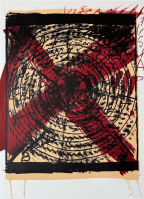
Details
Artist
Styles
// Antoni Tàpies' Aparicions-1 (1982) is an etching that reflects the artist's characteristic approach to materiality, symbolism, and abstraction. This limited edition print, with an edition size of 99, features a large, blue, mirror-like shape central to the composition, surrounded by abstract marks and symbols that evoke a sense of mystery and introspection. Tàpies combines textured backgrounds with calligraphic gestures, creating an almost dream-like atmosphere. The work invites viewers to explore themes of reflection, perception, and the passage of time, encouraging an internal dialogue on the nature of appearances and reality. Tàpies’ signature abstract and symbolic style connects deeply with Catalonian cultural heritage, adding layers of interpretation to the viewer's experience.
Aparicions-1 , 1982
form
Medium
Size
56 x 76 cm
- Inches
- Centimeters
Edition
Price
- USD
- EUR
- GBP
Details
Artist
Styles
// Antoni Tàpies' Aparicions-1 (1982) is an etching that reflects the artist's characteristic approach to materiality, symbolism, and abstraction. This limited edition print, with an edition size of 99, features a large, blue, mirror-like shape central to the composition, surrounded by abstract marks and symbols that evoke a sense of mystery and introspection. Tàpies combines textured backgrounds with calligraphic gestures, creating an almost dream-like atmosphere. The work invites viewers to explore themes of reflection, perception, and the passage of time, encouraging an internal dialogue on the nature of appearances and reality. Tàpies’ signature abstract and symbolic style connects deeply with Catalonian cultural heritage, adding layers of interpretation to the viewer's experience.
- Recently Added
- Price (low-high )
- Price (high-low )
- Year (low-high )
- Year (high-low )
Antoni Tapies
Primer Congreso Nacional De Neuropedriatria, 1982
Limited Edition Print
Etching
EUR 1,875
What is Found Object?
A found object is a term used to describe a man-made or natural object, or a fragment of one, that an artist discovers or purchases and keeps for inspiration or as a work of art. The artist may also modify the object or incorporate it into a collage or assemblage, transforming it into a new piece of art.

























































































































